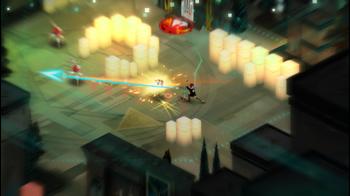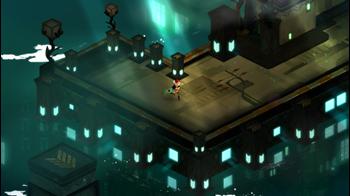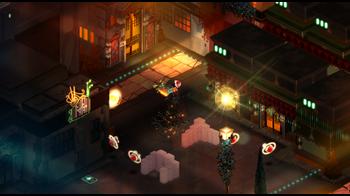
Transistor Review
Supergiant created a surprise success with their first game, Bastion, in 2011. Coming from an unknown studio and debuting to the public without backing from any major publishing house, Bastion remarkably turned out as one of our RPG of the Year contenders. It’s safe to say we’ve been eagerly looking forward to the sophomore title from modest team at Supergiant. From Transistor’s first unveiling a little more than a year ago, it was clear that Supergiant still had a knack for visual artistry and style. But they made it clear they wanted to do something slightly different this time around.
Transistor is, in brief, an isometric action RPG. That might sound like Bastion at first, and while there are shades of Bastion in this game, don’t get the wrong idea. Transistor is quite different, especially when it comes to combat and skill mechanics. You control our heroine Red as you walk through the ultramodern civilization of Cloudbank. First of all, the entirety of the game runs along a single path - there is no hub world or separated locations. Enemies, known as the Process, are encountered along the gameplay path, always in groups. Red must eliminate all enemies using skills known as Functions before moving on along the path, as though they were checkpoints. The game is quite linear in this regard, with only a few diversions off the main path of the game. It’s clear that exploration is not a primary gameplay focus here. That instead falls to the combat system and supporting subsystems.
Enemies can be fought in real time similar to as they would be in Bastion. However, Red can also use an ability known as Turn() to stop time and prepare a sequence of Functions to run on the enemy group rapidly in succession. You have as much time as you want to set up your sequence, and you can write or rewrite your sequence as often as you want until you finalize your decision. The downside to using Turn() is that Red must go through a mandatory cool-down period afterwards where none of your Functions will be available for a time. In addition, Red can only perform so many Functions during Turn() - I’ll go into detail on that momentarily. If you couldn’t tell already, Transistor incorporates quite a bit of programming diction into the nomenclature of the game.
The core of Transistor comes down to its skill system. I’m going to go into some detail here as this is the backbone to the gameplay. There are more than a dozen Functions that become available to the player, and four Active Slots that chosen functions can be assigned to, one for each face button on the PS4 controller. Many of the functions are various types of attacks, such as a swing of the Transistor sword or shooting an energy ball or laser. Some functions are better suited against individual enemies and some are better at crowd-control. There are some non-offensive Functions as well, such as a cloaking ability and an evasion technique. Different functions also have a different Turn() cost, where hard hitting abilities will take more of your allotted time during Turn() than weaker abilities.
But each Function is multipurpose. Not only does each have an Active action for use in combat, but any Function can instead be used as an Upgrade for another function if desired. Each Active Slot is accompanied by two Upgrade Slots that Functions can also be assigned to. To illustrate, two of the Functions you receive are Bounce() - a ricocheting bolt that jumps from target to target, and Ping() - a rapid-fire beam. Bounce() can upgrade Ping() by adding a ricochet effect to the beam, or alternatively Ping() can be used to upgrade Bounce() to dramatically speed up that attack. However, each Function has a Memory cost associated with it, so you can’t just place away all the best Functions all over the place. You have to decide which Functions you want to use and how to best utilize the total amount of Memory you have available.
In addition to this, there are also Passive Slots that any Function can also be assigned to, giving passive bonuses in battle. For instance, Bounce() will give Red a deflecting shield to negate some damage towards her, while Ping() allows Red to move much further during Turn(). So in short, a single function can be used in three different ways depending on what slot it is used in. Considering the numerous Functions and Slots available, there are many permutations of skill set-ups that can be achieved. This leads to hundreds of ways you can build your arsenal depending on how you want to approach the combat. It’s a very versatile system and you can change your build at any Access Point along the path, which come by often enough so it’s never long before you run into one. Experimentation is not only unobtrusive - it’s quite enjoyable to try out a bunch of different combinations, seeing all the various effects you can achieve.
Enemies give experience in a typical fashion, and leveling up unlocks more Functions and Slots to use. However there is one last element to describe, which are Limiters you obtain as you progress through the game. These are somewhat analogous to the Shrine bonuses in Bastion. Essentially each Limiter can be turned on to increase the EXP Red will gain. However, it will also make the game more difficult in some way, such as making enemies more difficult to kill, or reducing the total amount of Memory available to you, forcing you to play with fewer Functions. When Red runs out of HP, one of her equipped Active Functions will Overload and become unavailable until the next Access Point. If all functions Overload, then there will be a game-over. Or at least I assume so - I never got to that point, even with all limiters on during my second playthrough.
Not to say the game is a cakewalk. If you are playing with a lot of Limiters active, using caution and planning your attack is essential to staying alive; from what order you tackle enemies, to how you balance your offensive and defensive skills, when and how you use Turn(), and how you use cover to avoid taking too much damage. In addition, you can retry from the last checkpoint at any time, so if things were going south, I decided to start over the encounter to approach things differently. The combat is methodical in nature, requiring planning and patience.
The first playthrough took me about eight hours to complete, but if you want to max out your character and Functions, a second playthrough is needed. Subsequent playthroughs, called Recursions, are essentially a ‘New Game Plus’, where Red will retain her level and Functions. However, all your foes also become more dangerous, so don’t expect for things to be any easier the second time around.
Finally, there are also additional ‘challenges’ that can be taken in a bonus room encountered at multiple points along the main gameplay path. These challenges consist of an assortment of tests, from defeating enemies within a time limit to surviving an onslaught for a set amount of time. However, I found that most of these challenges weren’t truly challenging and I found myself wishing there were some that involved more planning or skill. There were a few nifty ideas thrown in the mix, however.
The sights of the game are for the most part very appealing, and you probably don’t need me to tell you that if you’ve been looking at any of the pre-release footage. Transistor is very colorful title, using deep hues in a very satisfactory way, and animations are smooth and refined. The game runs at a steady framerate most of the time, but sometimes the game will significantly stutter during encounters with numerous enemies and a lot of effects happening on-screen. It’s not a big deal in the big picture however.
I don’t want to delve too deep into the narrative elements as to not spoil anything, but is fairly simple and modest story. Red’s tale largely involve pursuing her attempted murderers to find answers about their motives and about the mysterious Transistor itself. It’s not exactly a gripping plot throughout the main course of the game, and it wasn’t a primary element in keeping me engaged, but ultimately I think the storyline ends on a mostly satisfactory note within the scope Supergiant was looking for. Most of the dialogue is spoken by the Transistor much like the Narrator in Bastion, so if you are familiar with that style of storytelling you have a good idea what to expect.
All in all, Transistor is an exceptionally gorgeous title with an enjoyable layered skill system. With all the different possible skill arrangements available, players who like to tinker and experiment will greatly enjoy all the options Transistor has to offer on this front. It’s clear that this was the major focus as a core element of the title. However, some might be put off by the linear structure of the world, short length, or meager storyline. In the end, Transistor is a delightful piece of entertainment and a worthy follow up to the well-acclaimed Bastion.


